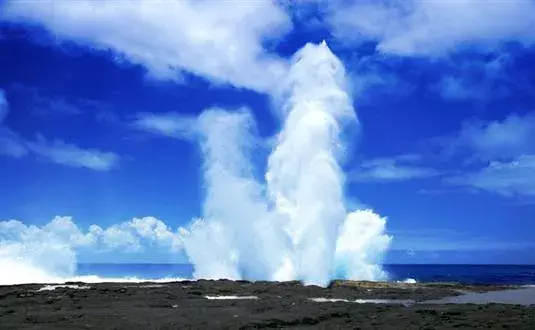
Alofaaga Blowholes
Overall Rating: ⭐⭐⭐⭐☆ (4/5)
Rating Breakdown:
✔ Historical Significance – ⭐⭐⭐⭐☆ (4/5)
✔ Cultural Impact – ⭐⭐⭐⭐⭐ (5/5)
✔ Atmosphere & Maintenance – ⭐⭐⭐⭐☆ (4/5)
✔ Accessibility – ⭐⭐⭐⭐☆ (4/5)
✔ Tourist-Friendly – ⭐⭐⭐⭐☆ (4/5)
Weather
- Tropical coastal climate
- Hot and humid year-round
- Rainfall more common from November to April
Tags
- Natural Wonder, Coastal Attraction, Photography Spot, Geological Feature
Timings
- Daily: 8:00 AM – 6:00 PM
- Best viewed during high tide for dramatic effects
Time Required
- 30 minutes to 1 hour
Entry Fee
- Approximately 5 Samoan Tala (WST) per adult
- Fee collected by the local village for maintenance
Things to See & Do
- Blowhole Spectacle – Watch seawater shoot up to 30 meters into the air through lava tubes
- Coconut Launching – Local guides demonstrate tossing coconuts into the holes to watch them fly
- Coastal Views – Take in panoramic views of the ocean and rugged volcanic coastline
- Photography – Capture dramatic action shots of the powerful water bursts
- Natural Soundscapes – Listen to the deep roars and hissing from the blowholes
Best Time to Visit
- During high tide or after rough seas for more active blowholes
- Dry season (May to October) offers clearer skies and safer conditions
Nearest Parking Spots
- On-site parking available at the entrance
- Located near the village of Taga on the southwest coast of Savai’i
Overview
- Natural Lava Formations – Created by ancient lava flows, the blowholes are a rare natural phenomenon
- Spectacular Water Displays – Waves force water through the lava tubes, resulting in high vertical jets
- Local Involvement – Villagers help maintain the site and offer demonstrations with coconuts
- Raw and Untouched Setting – The surrounding coastline is rugged, unspoiled, and powerful
- Educational and Entertaining – Visitors get a glimpse of volcanic geology in action
- Main Blowholes – Large, active lava tubes near the cliff edge, capable of launching water sky-high
- Observation Points – Flat lava rock platforms provide close but safe viewing
- Coconut Demonstration Area – Local guides showcase how the pressure can launch coconuts
- Lava Rock Formations – The area is filled with jagged black rocks, adding a dramatic aesthetic
- Formed from lava tubes during ancient volcanic eruptions on Savai’i
- Used by locals for generations as a place of wonder and storytelling
- Incorporated into eco-tourism in recent decades by the Taga village
- Continues to be a cultural and geological point of interest for both tourists and researchers
- Stories passed down include mythological significance tied to Samoan legends
- No formal structures; the site is natural and minimally altered
- Basic walking paths and stone markers guide visitors to safe zones
- A small wooden hut is often present for fee collection and local interaction
- Rugged terrain with uneven surfaces—proper footwear is necessary
- Open landscape with minimal shade, so sun protection is advised
- Safety First – Keep a safe distance from the edge and do not walk on wet or slippery rocks
- Footwear – Wear sturdy shoes suitable for walking on rough lava surfaces
- Sun Protection – Bring a hat and sunscreen, as there's little shelter from the sun
- Respect the Site – Follow local instructions and support the community by paying the entrance fee
- Photography – Set your camera to burst mode to catch the blowhole in action
- Location – Near Taga village, southwest Savai’i
- By Car – About 1.5 hours from the Salelologa ferry terminal
- By Tour – Frequently included in Savai’i island tour packages
- Public Transport – Limited; hiring a car or taxi is recommended
- Parking Availability – Free on-site parking near the entrance, managed by the local village